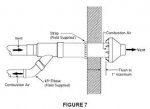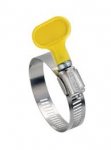Alloy
Well-known member
Some more upgrades this weekend. I found some flexible exhaust ducting that is leak-proof. And it only cost $40 instead of the $80 that I spent on the electrical conduit material. I did have to twist a short length of conduit onto the exhaust ducting so that it fit tightly in my coupler. But the end product works great, and is completely air-tight.
I also installed rivnuts and thumb screws to hold the intake and output hoses in place, so I won't have to fight with the circular clamps anymore.

We use a Proflex to heat our 35' (280sqft) trailer. With jus the Proflex it takes about 4-5 hour to bring the temp from 32F up to 60F. Exhaust gas temp of the Propex is +/- 150F while the RV furnace is over 250F which means the Proflex is more efficient.
For maximum efficiency I kept the exhaust to 48" and the heating duct is 36" of 4" steel duct. There is no intake ducting
A concentric vent I made with 1" and 2" aluminum pipe exhausts through the side of the trailer.

Some ideas.
For the exhaust Home Depot has Home-Flex stainless gas pipe. TracPipe and Gastite also make it.

Some quick release hose clamps




